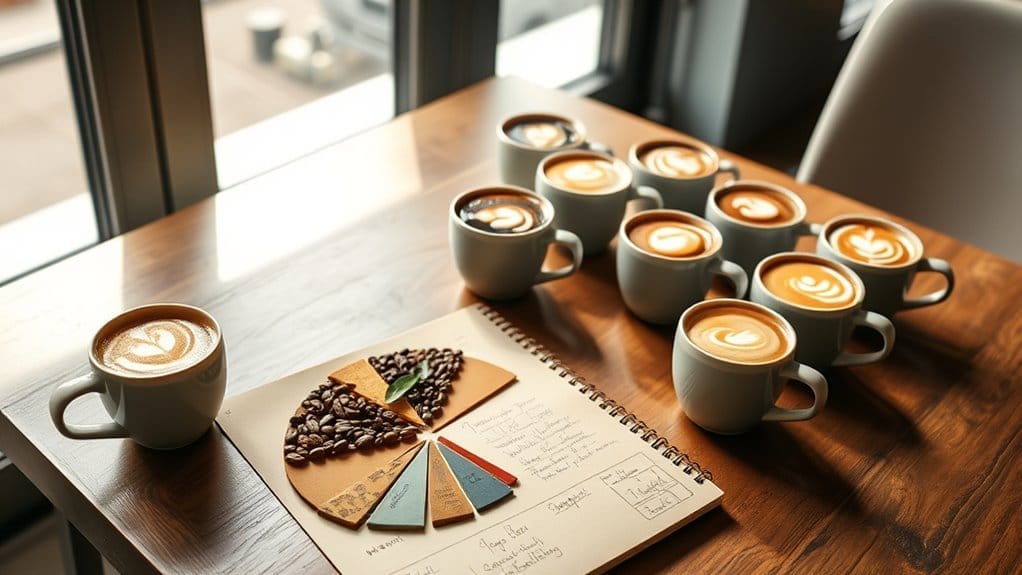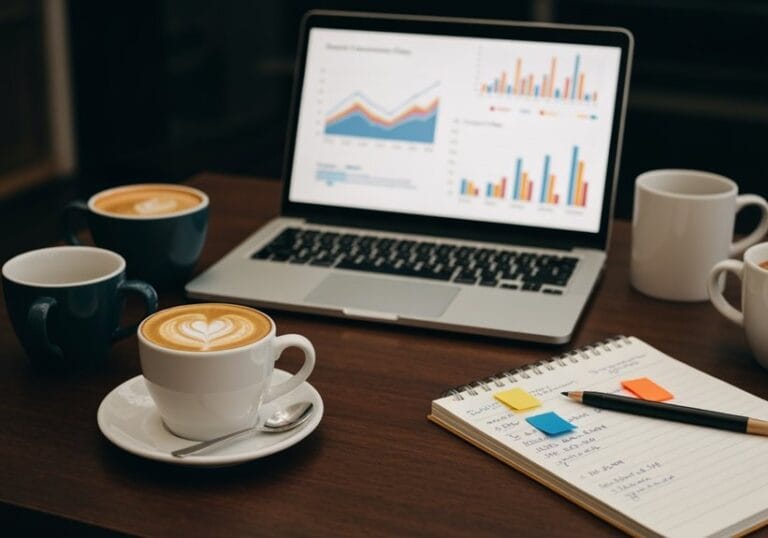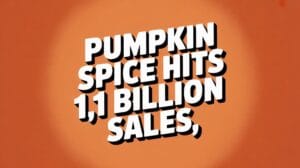The coffee scene is buzzing! By 2025, the global coffee market might hit a whopping $473.10 billion—wow! Americans are chugging coffee like it’s water, especially millennials and Gen Z, who love their custom coffee creations (I mean, have you seen some of those concoctions?). With specialty coffee booming and tech turning home brewers into barista wannabes, coffee culture is evolving fast. Stick around, there’s more to spill about this caffeinated adventure!
Key Takeaways
- Global coffee market revenue is projected to reach USD 473.10 billion by 2025, highlighting sustained growth.
- Northeast U.S. residents consume an average of 1.97 cups daily, with Michigan leading at 2.52 cups.
- Specialty coffee consumption surged to a 14-year high in 2025, particularly among individuals aged 25-39.
- Gen Z influences trends toward customizable coffee options, favoring health-conscious choices such as decaf.
- Coffee shops are increasingly adapting to consumer needs by becoming social hubs equipped with essential amenities like Wi-Fi.
Global Coffee Market Overview
In regard to coffee, the world is a bustling café with more activity than a bean at a barista contest!
The global consumption of coffee is booming, with market revenue expected to hit a staggering US$473.10 billion by 2025! Coffee statistics paint a tantalizing picture: did you know that by 2030, it’s projected to hit US$369.46 billion? Crazy, right?
Global coffee consumption is skyrocketing, with revenue soaring to a jaw-dropping US$473.10 billion by 2025!
Notably, Europe holds a hefty 34% of this market, proving that fancy lattes and espressos reign supreme!
And let’s not forget the younger folks—Gen Z is diving into this caffeinated wonderland, shaping coffee consumption worldwide, especially as younger coffee drinkers initiate their habits around the age of 15!
Who knew a simple cup could brew such a vibrant culture? It’s like coffee is the magic potion of our time—spilling energy, creativity, and, okay, a lot of caffeine-fueled shenanigans!
Regional Consumption Patterns
Coffee consumption isn’t just a quirky habit; it’s practically a lifestyle choice that varies wildly from region to region!
When looking at coffee consumption stats, it’s shocking how much the average cups consumed can differ!
- In the Northeast, folks sip an average of 1.97 cups daily.
- Michigan tops the list with an impressive 2.52 cups per person.
- Western U.S. leads in specialty coffee drinkers—58% indulge weekly!
- Meanwhile, Utah lags behind with just 1.29 cups.
- Surprisingly, the Midwest isn’t too far off, hitting a solid 50% for specialty brews!
These coffee usage statistics are a wake-up call—coffee consumed in America is way more than just a morning ritual; it’s practically a caffeine-fueled sport!
Trends in Specialty Coffee

How does one even keep up with the whirlwind of trends in specialty coffee? Seriously, it’s like trying to nail jelly to a wall!
Keeping up with the ever-changing specialty coffee scene is no easy feat—it’s like herding cats on a caffeine high!
In 2025, specialty coffee consumption in the US hit a 14-year high—can you believe it? A whopping 64% of folks aged 25–39 immerse themselves in specialty brews weekly. The premium coffee segment is rapidly expanding, showcasing how much consumers are willing to invest in quality.
Out-of-home sips are where it’s at too, with 35% of specialty fans preferring cafes to their kitchen counters (who can blame them?).
And get this—Gen Z is switching things up, craving more custom options over traditional fancier coffees.
Plus, there’s this growing love for decaf—all those health-conscious peeps just want to sip without the jitters! Interestingly, the global coffee culture is evolving, turning coffee shops into social hubs and remote workspaces with amenities like Wi-Fi.
All these consumer trends and demographics are reshaping how we caffeinate!
Impact of Technology on Coffee Industry
The era is past when brewing a perfect cup of coffee meant balancing a precarious tower of gadgets while hoping the whole setup wouldn’t implode!
Modern technology is transforming the coffee scene like never before. Just check out these key changes:
- Automation streamlines brewing, reducing costs and labor.
- Smart machines are turning home brewers into baristas.
- Digital ordering is now a must-have for engaging customers.
- Analytics help shops track every bean and brew!
- Coffee shop statistics worry about wait times now—no more standing in line!
As statistics about coffee consumption show, American coffee consumption continues to rise alongside this tech revolution. The impact of pump systems has notably improved the taste and consistency of coffee, further captivating consumers.
Even coffee chains are adapting store models, blending tradition with innovation to keep their brews fresh and relevant! Who knew coffee could be this exciting?
Frequently Asked Questions
What Age Group Drinks the Most Coffee Globally?
Older adults aged 60 and above globally consume the most coffee, with approximately 73% reporting daily consumption. Their increasing coffee drinking trends stand in contrast to younger age groups, who also show significant interest.
How Does Climate Change Affect Coffee Production?
Climate change substantially impacts coffee production through rising temperatures, extreme weather events, and decreased suitable land, leading to fluctuating yields, reduced quality, and increased market volatility, threatening farmers’ livelihoods and global supply stability.
What Are the Health Benefits of Coffee Consumption?
Coffee consumption offers numerous health benefits, including reduced risks of cardiovascular disease, certain cancers, and type 2 diabetes. Furthermore, it may enrich neurological health and improve liver function, contributing to general improved well-being.
Which Coffee Varieties Are Most Popular Among Consumers?
Arabica varieties, particularly Typica and Bourbon, dominate consumer preference due to their balanced flavors and appealing sweetness. Specialty coffees, including unique blends, are gaining traction as consumers seek diverse and quality coffee experiences.
How Does Coffee Pricing Vary Across Different Regions?
Coffee pricing varies noticeably across regions due to factors like production costs, currency fluctuations, and local demand. Premium varieties command higher prices, while Robusta remains cheaper in regions like Vietnam, contributing to general market disparities.
References
- https://www.gourmetpro.co/blog/coffee-market-trends-expert-insights
- https://apps.fas.usda.gov/psdonline/circulars/coffee.pdf
- https://www.precedenceresearch.com/coffee-market
- https://coffeebi.com/2025/07/20/global-coffee-consumption-trends-2025-youth-specialty-and-market-expansion-drive-growth/
- https://worldpopulationreview.com/country-rankings/coffee-consumption-by-country
- https://www.grandviewresearch.com/industry-analysis/coffee-market
- https://tradingeconomics.com/commodity/coffee
- https://www.accio.com/business/coffee-consumption-trends



